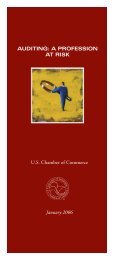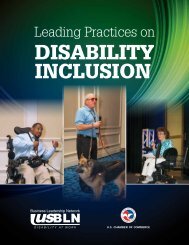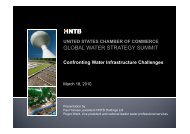Trends in Union Corporate Campaigns - US Chamber of Commerce
Trends in Union Corporate Campaigns - US Chamber of Commerce
Trends in Union Corporate Campaigns - US Chamber of Commerce
You also want an ePaper? Increase the reach of your titles
YUMPU automatically turns print PDFs into web optimized ePapers that Google loves.
OBJECTIVES<br />
Sometimes, where employers already have unionized workforces,<br />
those “benefits” take the form <strong>of</strong> contract concessions, and<br />
sometimes, where the union has policy <strong>in</strong>terests, they take the<br />
form <strong>of</strong> political concessions. Recent campaigns by the so-called<br />
Coord<strong>in</strong>ated Barga<strong>in</strong><strong>in</strong>g Committee, represent<strong>in</strong>g fourteen unions<br />
with members employed by General Electric, are an example <strong>of</strong><br />
the former. The 2005 campaign by organized labor aga<strong>in</strong>st the<br />
Bush adm<strong>in</strong>istration’s proposed Social Security reforms, <strong>in</strong> which<br />
the unions pressured <strong>in</strong>dividual f<strong>in</strong>ancial services companies to<br />
drop their support for the plan, illustrates the latter. But most <strong>of</strong><br />
the action <strong>in</strong> corporate campaigns today, and certa<strong>in</strong>ly the most<br />
extensive and most aggressive campaigns, are centered on efforts<br />
to organize workers.<br />
The earliest corporate campaigns, such as those at Farah and J.P.<br />
Stevens <strong>in</strong> the 1970s, were focused on organiz<strong>in</strong>g, but <strong>in</strong> that era<br />
the explicit objective was to br<strong>in</strong>g about representation elections<br />
as provided under the National Labor Relations Act. In these<br />
elections, once at least 30 percent <strong>of</strong> workers <strong>in</strong> a prospective<br />
barga<strong>in</strong><strong>in</strong>g unit sign cards petition<strong>in</strong>g the National Labor Relations<br />
Board (NLRB) to conduct a secret-ballot election, the regional<br />
<strong>of</strong>fice(s) <strong>of</strong> the NLRB will adm<strong>in</strong>ister a vote, usually <strong>in</strong> the<br />
workplace itself. As <strong>in</strong> all th<strong>in</strong>gs bureaucratic, there are rules <strong>of</strong><br />
procedure, the basic result <strong>of</strong> which is that both the union and the<br />
company are permitted to communicate their views to the workers,<br />
after which the workers mark their ballots. The NLRB tallies the<br />
votes and, if a majority <strong>of</strong> workers so <strong>in</strong>dicate, certifies the union as<br />
their barga<strong>in</strong><strong>in</strong>g agent. The employer is then required to barga<strong>in</strong><br />
with the union. We can th<strong>in</strong>k <strong>of</strong> this as retail organiz<strong>in</strong>g — ga<strong>in</strong><strong>in</strong>g<br />
the right to represent workers from the bottom up, vote by vote.<br />
This procedure is illustrated <strong>in</strong> Figure 2(a).<br />
<strong>Trends</strong> <strong>in</strong> <strong>Union</strong> <strong>Corporate</strong> <strong>Campaigns</strong><br />
21


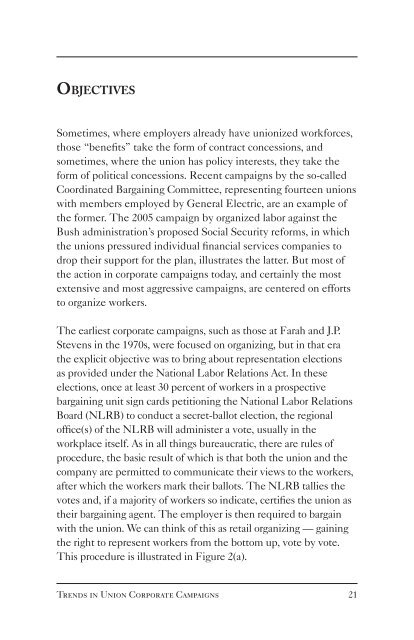



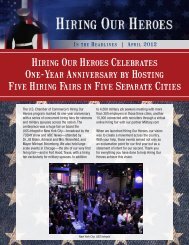
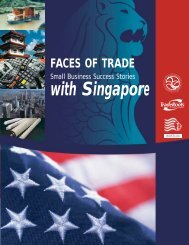

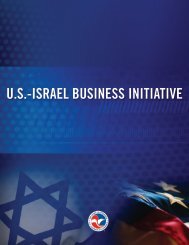
![[PDF] A Response by the International Organisation of Employers to ...](https://img.yumpu.com/41807569/1/184x260/pdf-a-response-by-the-international-organisation-of-employers-to-.jpg?quality=85)
